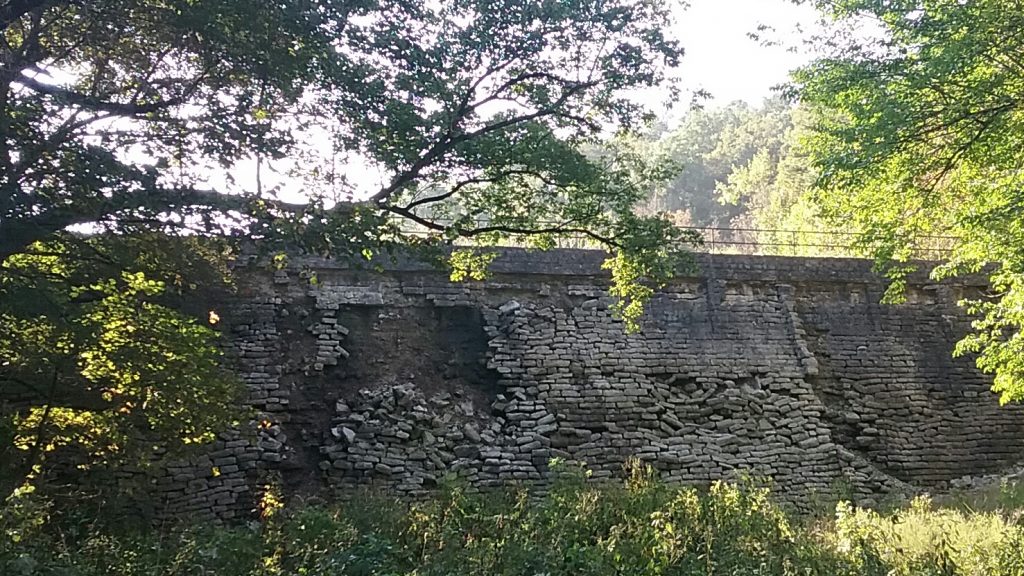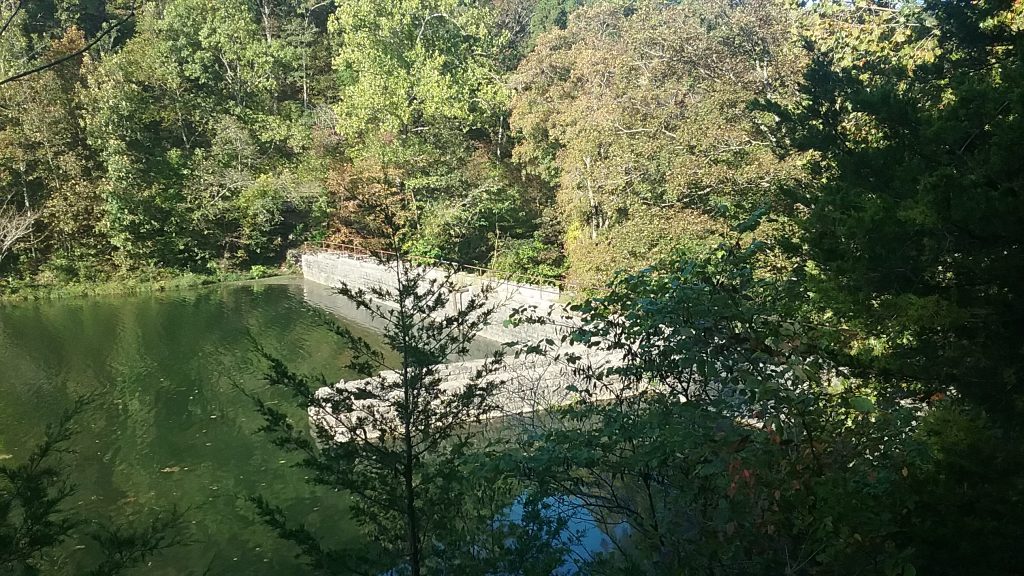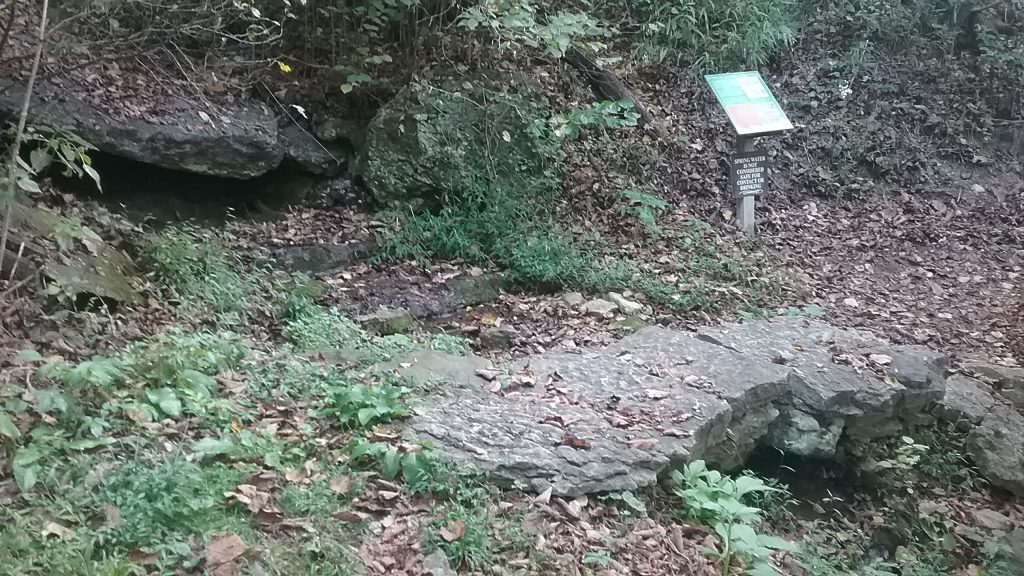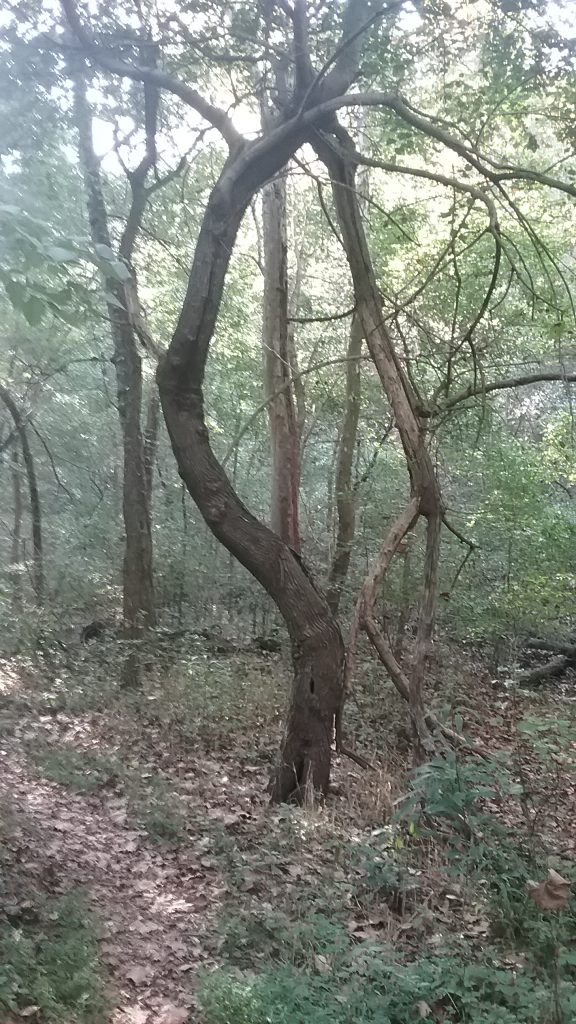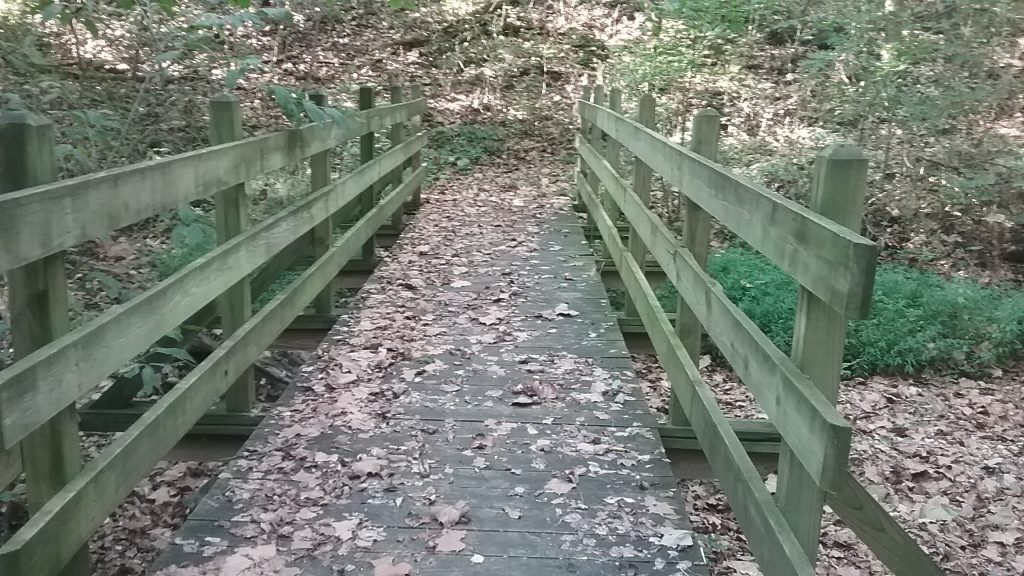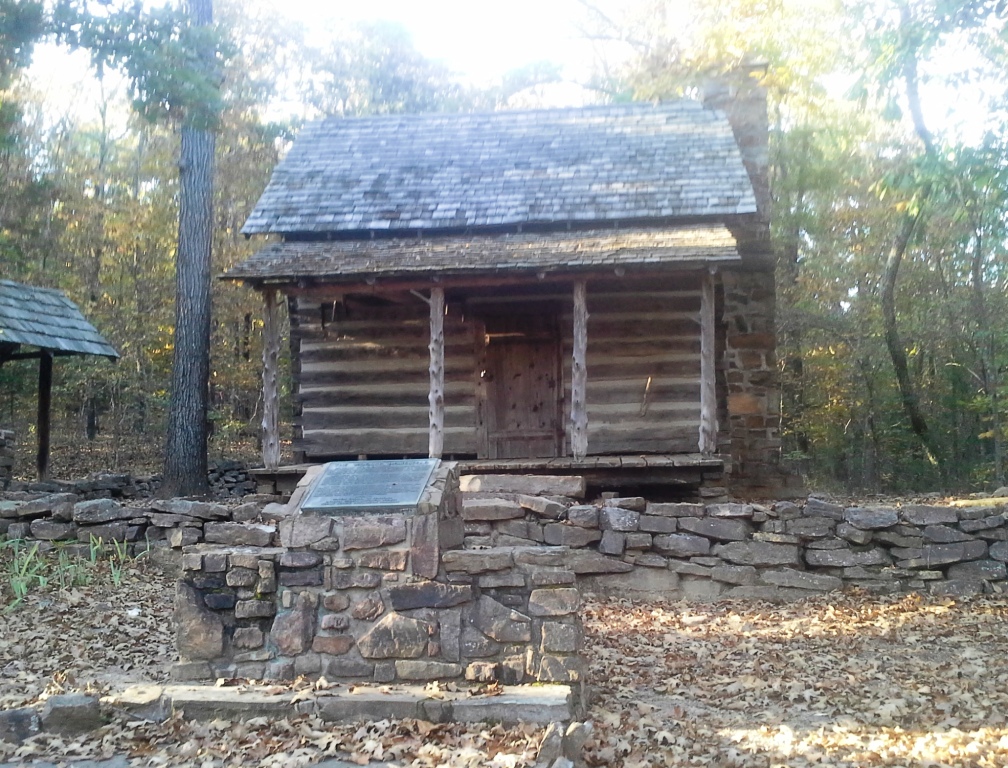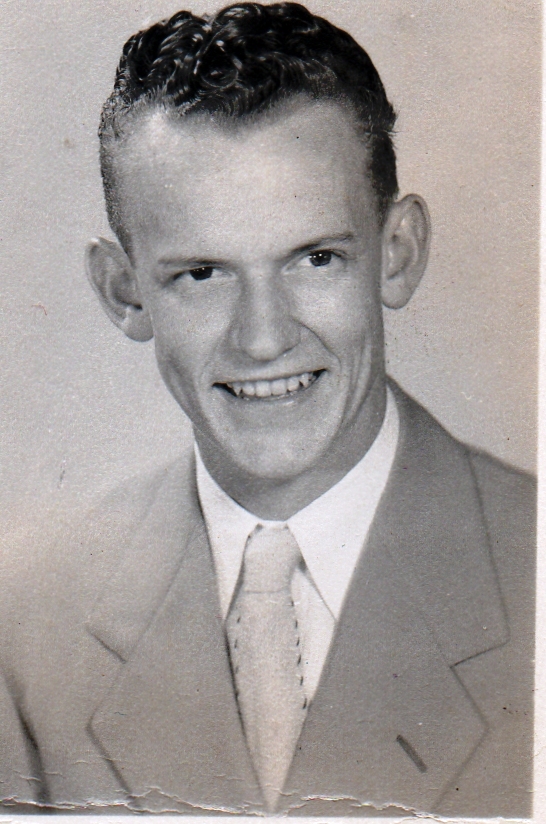I’ve been browsing wildlife range maps for more than forty years. I find them fascinating. Below is the range map of the Grizzly Bear showing both the present day (striped) and the year 1500 (yellow). As you can see, it shows the Grizzly Bear being present in 1500 in the western Ozark hills. The map was included in a recent Washington Post story.
John Entwistle Quote of the Day
I think Sarah likes this quote.
I ain’t quiet – everybody else is too loud.
Doris Groblebe O’Connor Visitation
Hiking Black Bass Lake
Black Bass Lake is the old city reservoir of Eureka Springs, Arkansas.
These buildings and signs are reminders of this pretty little lake’s history.
The old crumbling rock dam is an interesting sight.
I followed the trail that hugs the lake for nearly a mile.
It is a pretty hike with several interesting features, including this spring.
I enjoyed looking at the trees during my jaunt. Notable were several majestic mature cedars of surprising height. I also spotted this crooked tree.
There were a couple of well maintained foot bridges across dry creeks that returned me to my point of beginning. I’ll have to return when the water is running.
Buzzards in the Barn
One day Ian was in the barn and a big buzzard swooped down from above and aggressively flew at him. It spooked him a bit. Turns out the buzzard had a nest hidden in the barn and she was defending it. Later, I started seeing two white chicks standing in the barn window, waiting for their mother. Or maybe cooling off as I imagine it gets pretty hot under that tin roof during the day. They are getting quite large and turning black now. The buzzards are of the black vulture variety.
Tarantula
Made my annual sighting of a tarantula today as it crossed the county road just out of the hollow.
Woolly Hollow State Park
We recently had opportunity to enjoy a short visit to Woolly Hollow State Park near Greenbrier, Arkansas in the foothills of the Ozarks. The 440-acre park is spread across more of a valley than a hollow (to my eyes) but was picturesque country nonetheless. I assumed that the name Woolly had some connection to sheep, but I was wrong. Instead, it is the surname of a pioneering family that came to the area from Tennessee in the early 1850s.
A highlight of the park is the rustic and historic Woolly Cabin.
 Since the summer season was over, some activities at the state park were curtailed. For instance, the swimming beach on 40-acre Lake Bennett was closed and deserted, as was the snack bar. The lake also has a marina with boat rentals. We did spend a few minutes perusing the small gift shop in the park’s headquarters building shortly before it closed for the day. Had we more time we could have enjoyed the many miles of hiking trails available or spent the night in the campground.
Since the summer season was over, some activities at the state park were curtailed. For instance, the swimming beach on 40-acre Lake Bennett was closed and deserted, as was the snack bar. The lake also has a marina with boat rentals. We did spend a few minutes perusing the small gift shop in the park’s headquarters building shortly before it closed for the day. Had we more time we could have enjoyed the many miles of hiking trails available or spent the night in the campground.
Crime Wave Averted in Berryville, Arkansas
This little item is from the November 1, 2016 edition of the Carroll County News, page 11:
Berryville Police Activity Report
October 24, 2016
7:00 pm – An officer responded to the report of a man lying in the road but discovered it was a dog.
Eddie Groblebe: An Ozark Original
ES Independent Column – David Worley Redux
I’ve walked around the Shady Grove Cemetery between Eureka Springs and Berryville numerous times looking at tombstones and the names inscribed. It is impossible to do so without noticing that two of this area’s most historic families, the Worleys and the Gentrys, are amply represented. Two men buried in the cemetery are David Worley and William Wesley Gentry.
I recently wrote about David Worley based on a short article that ran in several regional newspapers in the year 1902. It said in part, “Eureka Springs, Ark., April 29 – Dave Worley, 85 years old, grandfather and great grandsire to more than a hundred living persons, died at his home on Keels Creek, five miles south of here, Sunday.”
I expressed some confusion as the article’s information didn’t match what I thought I knew about Mr. Worley. Paula Breid kindly alerted me that this very topic had been extensively researched by sisters Lucy Johnson Kell and June Johnson Westphal. They wrote about their findings in an article titled “Our Elusive David Worley” in the June 2001 edition of the Carroll County Historical Quarterly.
What they found is that the newspaper reporter had likely confused the particulars of two different deaths that occurred in the Keels Creek area within a few days of each other. William Wesley Gentry also died in April 1902 and the details of his life and family closely match those of the newspaper article.
Mr. Gentry would have been nearly 85 at the time of his death, while David Worley was only 63. Also, the man in the newspaper article is said to be the “grandfather and great grandsire to more than a hundred living persons.” Records show that David Worley had 16 grandchildren at the time of his death, all under the age of 13. William Wesley Gentry, on the other hand, is said to have had 62 grandchildren and numerous great-grandchildren.
These elements and other evidence uncovered by Lucy Kell and June Westphal seems to conclusively solve the mystery and confusion caused by the original 1902 article that landed on the front pages of newspapers from Little Rock to St. Louis.
ES Independent Column – Amos Ratliff
There have been several different unrelated Ratliff families live in the Eureka Springs area since the founding of the town in 1879. One such family consisted of John and Christena Ratliff and their two sons, Amos and Charlie. They arrived in Carroll County in the late 1890s from Lawrence County, Ohio. The marriage dissolved soon after and John Ratliff returned to Ohio, leaving Christena to raise the two boys.
At the age of 20, son Amos married Beulah Jones of Eureka Springs, but the union was not a happy one. They separated about the time that Amos was jailed for robbery, reputedly to raise money for gifts for his wife.
When he was released from jail on September 20, 1920, he found Beulah in a buggy with prominent local farmer John Berry. Amos shot them both in the back. Mr. Berry, age 25, died, but Beulah survived. John Berry was buried in Beulah Union Cemetery south of Eureka Springs in an unmarked grave. Records show that a veteran’s tombstone was later acquired for Mr. Berry, a WWI veteran, by Congressman Claude Fuller.
While awaiting trial for murder, Amos Ratliff was released on bail and had the idea he could regain his now ex-wife’s affections if he had money to yet again buy her gifts.
Winifred Frazier lived south of Eureka Springs on 40 acres she’d purchased after moving to Arkansas from Kansas. It is believed that Amos Ratliff thought that Miss Frazier was going to withdraw a large amount of money from the bank on the day he robbed and murdered her. She had been to the bank that day, but had only withdrawn enough money to cover her small farm’s expenses. I’m told by a local old-timer who remembers hearing about the murder that so much blood had soaked into the wooden floor of Winifred Frazier’s house it had to be chipped away with an axe.
Amos Ratliff eluded the law for a time, but the fugitive was finally captured and stood trial for the murder of Frazier. He was sentenced to death and electrocuted October 14, 1921 in Little Rock.
ES Independent Column – David Worley
While doing some research, I came across this short article that ran in newspapers from St. Louis to Little Rock in the year 1902:
“Eureka Springs, Ark., April 29 – Dave Worley, 85 years old, grandfather and great grandsire to more than a hundred living persons, died at his home on Keels Creek, five miles south of here, Sunday. He had fifteen children by his first wife and nine by his second. In the funeral train was a wagon in which rode one of his granddaughters with ten of her children ranging from one to twelve years. The remainder of them were compelled to find other accommodations. Fifteen years before the war, Uncle Dave was a slayer of bears and trapper of wide renown throughout North Arkansas.”
When I was a teenager, Jack McCall gave me some catnip and told me to give it to the young cat that I’d recently adopted at the Good Shepherd Humane Society. Miss Kitty still ranks as my favorite cat. Grandpa Jack meant for the catnip to be a treat for her, and it certainly was. She swooned and purred and didn’t know what to do with herself. I didn’t get quite that excited after finding this article, but almost.
But as tantalizing as this information is, I don’t know what to do with it because it doesn’t seem to fit anywhere. There is a David Worley buried in the Shady Grove Cemetery, but he was only 63 at death. He married a relation of mine, Jemimah Harp at Cassville, Mo., in 1865. He’d recently returned to the Ozarks after being released as a prisoner of war in Georgia. This David Worley only had eight children of his own that I’ve been able to trace, though he did gain an additional seven step-children when he remarried after Jemimah’s death. I’ve never been able to come up with the name of his parents, so the Uncle Dave Worley of the article could be his father. Or uncle.
Either way, the “slayer of bears” sounds like quite an interesting character.





